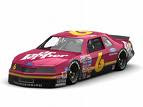What do I need?
A clear plastic bottle
Liquid hand soap that has glycol stearate in it
Water
Food coloring
Clear tape
Fill the bottle or jar about 1/4 full with liquid soap. Add a drop or two of food coloring. The coloring will make the swirls easier to see. Turn on your tap so you have just a trickle of water. Fill the bottle all the way to the very top.
Turn on your tap so you have just a trickle of water. Fill the bottle all the way to the very top.
Screw the cap on the bottle. Turn the bottle upside-down a few times to mix the soap and water. If you get foam, take the cap off and trickle some more water into the bottle. The foam will run over the edge. Recap the bottle tightly.
Dry the bottle and the cap, then wrap clear tape around it so the bottle won't leak.
- Twirl the bottle slowly. What do you see? What happens when you stop twirling the bottle? What happens if you spin it quickly?
- Try shaking the bottle up and down or side to side. What different patterns do you see inside the bottle?
If the liquid inside the bottle looks like it's all one solid color, just twirl or shake it again to make more patterns. If the cap on the bottle is sealed, Go with the Flow can last for years.
- Why can I see patterns in the water?
Normally, you can't see how the water is moving inside a full jar of water. Water that's moving in one direction looks the same as water that's moving in another direction. But glycol stearate, the chemical that gives some liquid hand soaps a pearly look, lets you see patterns flow in water.
- What kinds of patterns can I see in my jar?Who cares about these patterns?
When you turn the bottle slowly, you'll probably see smooth streaks in the water. When layers of water are moving slowly and smoothly past each other, you get this pattern, which scientists call laminar flow.
When you suddenly stop turning the bottle, or when you turn it very fast, you may see lots of swirls and wavy patterns. When one layer of water moves rapidly past another layer of water, it causes turbulence, which you see as swirly patterns.
When people design airplanes, cars, boats, golf balls, and other things that move through air or water, they study the patterns blowing air or flowing water makes as the object moves through it. Differences in the flow of air or water can affect how well an airplane flies, how much mileage a car gets per gallon, how fast a boat can go, or how far a golf ball will fly when you smack it with a club.
Thursday, March 27, 2008
Go with the flow
Posted by
Leslie
at
9:36 PM
0
comments
![]()
Labels: air patterns, science experiment
Wednesday, March 26, 2008
How to Dye Celery
Things you’ll need:
A glass, big enough to hold celery stalks and leaves upright
Food coloring
Water
Fresh celery stalks
Cutting board
Knife
1. Fill a glass of water about half full of water and then add some food coloring to the water. Dark or bright colors show up best.
2. Check the celery every hour. After about an hour, it will start to show some of the food coloring going up the stalk. You can measure how far the color goes up the stalk every hour. In time, most of the celery will be colored.
3. Water is absorbed by a plant. It travels up the stalk and then goes into the leaves. This is an explanation of how water is circulated in plants. You will need to leave some leaves on your celery stalk, as a plant's circulation works by "transpirational pull" — that is, the leaves are breathing.
Word Bank:
water, celery, dye, plant, mix, spoon, stalk, circulation, leaves, breathe, measure, experiment.
Posted by
Leslie
at
9:30 PM
3
comments
![]()
Labels: dye celery, science experiment
Tuesday, March 25, 2008
Paper planes

Build a special paper airplane to demonstrate how and why airplanes and most birds can fly (when they're not flapping their wings). Cut out the airplane's shape along the dark solid line. Next, fold the top half at the dotted line so that it meets the bottom half. Don't, however, fully crease the paper at the fold (we want to make a nice 'tear drop' air foil shape).
After folding the paper back, put a small piece of tape at the wing tips and at the center at the points marked A, B, and C. Now fold the plane along the center crease so that it creates a flattened out 'V'. The angle of the 'V' should be no more than about 15 degrees. Test fly the plane and adjust its stability.
Keep the nose of the plane from rising (stalling) by adding a small weight to the nose (point D), a paper clip or two does nicely. You can also adjust how much the plane dives or climbs by cutting small slots in the tail of the plane and bending the paper at the cuts up or down. Experiment with putting them up or down and seeing what effect that has on the way the plane flies.
What's going on?
Contrary to popular belief, airplanes don't float on the air, they're sucked up into it. This reason is known as Bernoulli's Principle. It says: "...as air travels faster [than surrounding air] across a surface, the air pressure against it is reduced...". By curving the top of an airplane's wing, air above it has to travel farther (as the distance is greater) than the air below, forcing the air to move faster.
The result is lower pressure on top and more pressure on the bottom. Another name for this is lift. The higher pressure below the wing is just like someone pushing from below the wing; the lower pressure above the wing is like someone pulling it up (like sucking on a straw to draw up milk in a glass).
If a wing has enough lift upwards, it moves upward, if a wing has lift downwards, it moves downward. The plane that we built, the "Bernoulli Plane" has a real airfoil and more closely resembles and flies the way that real planes and most birds do.
Posted by
Leslie
at
9:24 PM
0
comments
![]()
Labels: paper planes, science experiment
Monday, March 24, 2008
Static Electricity
Static electricity occurs, for example, when you rub a balloon on your shirt. The friction between the cloth and the balloon causes electrons to transfer from your shirt to the balloon. The shirt then has an overall positive charge because it has more protons than electrons. The balloon takes on a negative charge because it has extra electrons. The balloon will then stick to the shirt or to another surface, such as a wall. 
Static electricity has many uses in homes, businesses, and industries. For example, the copying machines found in most offices are electrostatic copiers. They make duplicates of printed or written material by attracting negatively charged particles of toner (powdered ink) to positively charged paper. Static electricity is also used in air cleaners called electrostatic precipitators. These devices put a positive electric charge on particles of dust, smoke, bacteria, or pollen in the air. Negatively charged collector plates attract the positive particles out of the air.
Posted by
Leslie
at
9:19 PM
0
comments
![]()
Labels: science experiment, static electricity
Wednesday, March 19, 2008
A bright idea!
Charge up a light bulb
Ever had this happen in your house - something gets broken and Dad goes over and takes a look at it. He studies it for a while and then suddenly - bing.... a little light bulb goes on above his head? Everybody in the house sighs and knows it's in everyone's best interest to get out of there - quick. 
In this experiment, we'll make a fluorescent light bulb 'go on' - literally. And no evacuation will be called for...
Take the comb and light bulb into a dark closet.
Take the comb and rub it thoroughly through your hair. If you don't have any hair, a wool shirt or sweater will work fine.
Now hold the comb to the metal end of the light bulb while carefully watching the filament in the bulb.
Pretty cool, huh? When you rub the comb through your hair, the friction between your hair and the comb actually causes electrons (a negatively charged subatomic particle. Electrons are found at varying distances from a atom's nucleus. They make up almost the entire volume of a atom but only account for a small part of the atom's mass.) to travel from your hair to the comb.
Your body (hair) becomes positively charged (because it has more protons than electrons) while the comb becomes negatively charged (it gained electrons from your hair) . The comb, in effect, becomes charged. When you touch the comb to the end of the light bulb, the charged comb discharges into the light bulb causing the bulb to emit small pulses of light.
Posted by
Leslie
at
9:17 PM
0
comments
![]()
Labels: charge up a light bulb, science experiment, static electricity
Monday, March 3, 2008
The Breathing Egg
Do eggs really breathe? Here's your chance to find out! In this egg-speriment, you'll discover the real truth about whether eggs actually breathe or not.
Question: Do eggs breathe?
Materials:
1 egg
small clear jar (clean jars work) or glass
hot water
magnifying glass
adult helper
Procedure:
1. Put the egg in the jar (without cracking it!) and fill the jar with hot tap water
(as hot as you can get it).
2. Set the jar on a table and watch it for several minutes.
3. If you see anything changing, examine it closely with the magnifying glass.
What Happened - and Why?
Tiny bubbles will start to appear on the egg shell. The bubbles will break free and float upward through the water. That's because the egg shell has tiny openings (so tiny, they are invisible to the naked eye) called pores. Each egg has about 7,000 pores. Inside the shell there's a small pocket of air. That air expands as it is heated by the hot water and "escapes" through the pores in the shell into the water as bubbles - making it look like the egg is breathing!
As easily as air can leave an egg, air can also enter an egg through those same pores, bringing different smells with it. Although the air can come out again through the pores, the smells stay inside. That's why if eggs are not stored in the egg carton you bought them in, they can take on the odours or tastes from other things in the fridge that smell - things like smelly meats, cheeses or onions. So, be sure to always keep eggs in their original egg carton in the fridge!
Posted by
Leslie
at
9:37 PM
0
comments
![]()
Labels: breathing egg, science experiment









